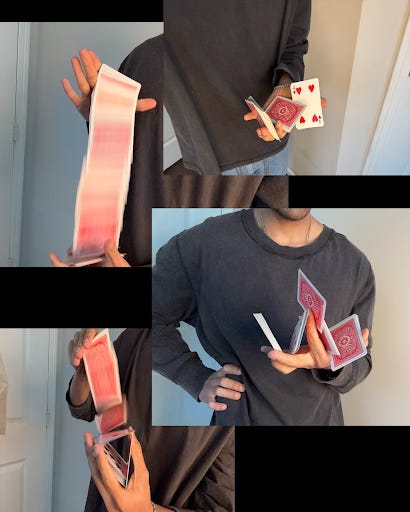The New Frontier
By Haider Ahmad
Many of us started in cardistry with a mindset of pure exploration for the sake of creating, pushing boundaries, and obsessing over what was next. For me, the process was always about going the opposite direction of what everyone else was doing. That’s where I found my space.
Early on, I realized that a lot of people in the community saved their best material for longform videos. And while that’s a beautiful tradition in its own right, I started to question whether it was the most impactful way to share what we do with the world. I started thinking on a larger scale, not in terms of virality, but visibility. Could cardistry exist outside our circle? Could it connect with the casual scroller on TikTok the same way it connects with someone who knows deeply about cardistry?
Turns out, it can.
But it takes a shift in mindset. You can’t approach social media like a gallery. It’s more like a stage in the middle of a crowd. And you have to perform, not by sacrificing your artistry, but by understanding the rhythm of attention. That’s something cardistry already teaches us: timing, pacing, contrast. The first second of a video is just like the opener to a move; it has to hit. The rest is just storytelling.
My creative process has always been rooted in experimentation. That didn’t change when I started making content for a wider audience. The only difference was who I was experimenting for. The average viewer doesn’t understand packet structure or grip complexity, but they do understand surprise, fluidity, and elegance. So I started to notice which moves read well, not just which ones felt cool (and am still observing).
There’s a reason magicians often go viral easily - they're still connected to what impressed them before they learned the trick. A lot of cardists, myself included, move past that stage quickly. We create for each other. And that’s beautiful. But if we want the world to appreciate cardistry, we have to sometimes remember what made us fall in love with it in the first place.
Our advantage as cardists is being able to build up and learn a repertoire that is much more impossible than someone who is not in our community. For example, a spring can be a spring triangle; a regular waterfall can be a one-handed waterfall; the Charlier Cut can be Waves, and so on. It’s not so much about “one-upping”, but setting the goal to be more oriented around how cool cardistry really is - there is definitely space for cute, complex, and everything in between. When you really lean into what makes cardistry look and feel cool, people notice, even if they don’t fully understand what they’re seeing. That doesn’t mean sacrificing depth. It just means being willing to share, and knowing that what makes a move impressive to the community might not be what grabs someone new.
Back when I started, there was a clearer divide between performers and creators. Now, it feels like everyone’s expected to be both. And maybe that’s a good thing. Maybe it pushes us all to think bigger. But it’s also okay to lean into what you love most. Some people thrive on grinding out the cleanest cuts imaginable. Others just want to make weird, beautiful shapes that feel new. Both are needed.
As for virality? It’s a side effect. Not a goal. If you tie your self-worth to numbers, it gets rough, fast. Trust me, I’ve been there. What kept me going wasn’t the views. It was the vision. I wanted cardistry to be seen. To grow. And that meant putting it out there, even if it meant getting low views at first. Even if it meant being misunderstood.
What I’ve found is that when you start treating cardistry like something worth sharing, not just showing, everything shifts. People can feel it. You don’t have to explain it. The rhythm, the shape, the timing - it carries. Whether you’re making content or creating moves, it’s all part of the same language.
About the author, Haider Ahmad:
I’m Haider Ahmad. I have done cardistry for around 10 years and was a semifinalist for the Fontaine Trials in 2022. I have always been someone who pushed against the norm and wanted to do the opposite of what I saw around me when it came to cardistry. That mentality led me to a lot of creative discoveries, and recently has brought me to a new space of realizing the lack of performing cardists promoting our art form at this time. I’ve taken it upon myself to take a look at the new frontier and inspire a new generation of cardists. You can find me on Instagram and YouTube @itscardistry.


